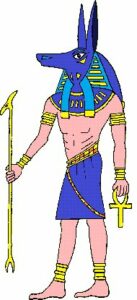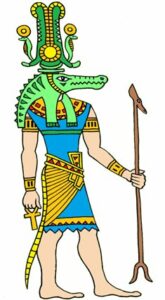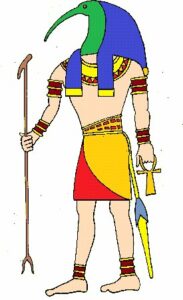The ancient Egyptians worshipped hundreds of gods and goddesses over more than three thousand years. This evolved over time, as it showed the changes in Ancient Egyptian society, politics, and even geography.
Some gods remained obvious, while others disappeared into obscurity, only to come back a few centuries later. Egyptian religion wasn’t static, it was vibrant, fluid, and deeply tied to every aspect of life, death, and nature.
From the soaring sun god Ra to the mysterious cat goddess Bastet, the number of Egyptian gods was vast. These celestial beings could change form, merge with other gods, or be worshiped differently in various regions of Egypt. Temples were built in their honour, rituals were performed to satisfy them, and great myths were told about their deeds and relationships. Many gods were represented in animal form, or as part-human, part-animal beings. To the Egyptians, animals were not just symbolic, they were seen as examples of divine energy.
Let’s talk about some of the more popular and enduring Egyptian gods, their roles, stories, and how they were seen.
ANUBIS – Guardian of the Dead
An ubis is one of the most legendary figures in ancient Egyptian religion. Well known for his jet-black jackal head, He was the god of funerary rites, embalming, and the afterlife.
ubis is one of the most legendary figures in ancient Egyptian religion. Well known for his jet-black jackal head, He was the god of funerary rites, embalming, and the afterlife.
This is why he was always seen as critical, as he protected graves, oversaw the mummification process, and guided souls through the underworld to the Hall of Truth where judgment took place.
Why did he have a jackal head? This is because Jackals were often seen prowling near cemeteries, which meant that the Egyptians associated them with death. However, they didn’t fear them as they believed that Anubis could use the jackal’s qualities to guard the dead from desecration and lead them safely to the afterlife.
Anubis also presided over the “Weighing of the Heart” ceremony. This is where the heart of the deceased was weighed against the feather of Ma’at. If the heart was lighter than the feather, the soul could enter the afterlife. If not, it was devoured by the fearsome creature, Ammit.
Though he was eventually overshadowed by Osiris in the role of ruler of the underworld, Anubis remained essential in Egyptian funerals throughout the millennia.
SOBEK – The Crocodile God of Strength and Fertility
 Sobek, also known as Sebek or Sobki, was a god who was linked with the Nile Crocodile. Crocodiles were common and feared in Egypt’s rivers and canals, which meant that Sobek was both respected and worshipped.
Sobek, also known as Sebek or Sobki, was a god who was linked with the Nile Crocodile. Crocodiles were common and feared in Egypt’s rivers and canals, which meant that Sobek was both respected and worshipped.
He was represented either as a crocodile or a man with a crocodile’s head, basically, Sobek symbolised the power and danger of the Nile.
However, Sobek’s influence went far beyond fear. He was the creator god in some myths, thought to have arisen from the primeval waters of chaos to bring order. He was thought to be a fertility god who brought water and growth to the land. His association with water and life also linked him to both birth and rebirth.
In addition, Sobek was connected to the strength and virility of the pharaohs.
Many rulers linked themselves with Sobek to show their power and authority. The powerful Middle Kingdom Pharaoh Amenemhat III even built temples dedicated to Sobek and was worshipped alongside him.
Sobek’s primary cult centre was in the Faiyum region, a lush area fed by a branch of the Nile. Temples such as the one at Crocodilopolis (the Greeks gave the town this name) housed live crocodiles thought to be sacred representations of Sobek. These crocodiles were adorned with jewels and fed special food. Upon their death, they were carefully mummified and buried with honour.
Sobek was worshipped from the Old Kingdom (c. 2686 BCE) through to the Roman occupation of Egypt, showing just how enduring his role was in the Egyptian imagination.
THOTH – God of Wisdom, Writing, and the Moon
 Thoth was one of the most resourceful and illustrious gods in Egyptian mythology. He was the god of writing, knowledge, science, wisdom, magic, and the moon. Often depicted as a man with the head of an ibis or a baboon, both animals sacred to him, Thoth was the ultimate scribe and advisor.
Thoth was one of the most resourceful and illustrious gods in Egyptian mythology. He was the god of writing, knowledge, science, wisdom, magic, and the moon. Often depicted as a man with the head of an ibis or a baboon, both animals sacred to him, Thoth was the ultimate scribe and advisor.
In Egyptian mythology, Thoth played an essential role in maintaining order in the universe. He was considered the inventor of hieroglyphic writing and the recorder of all knowledge. Every spell, every law, every important event—Thoth was there to record it. Scribes, one of the most respected professions in ancient Egypt, often prayed to Thoth for guidance and success in their work.
One of his most important responsibilities was during the “Weighing of the Heart” in the afterlife. While Anubis conducted the weighing, Thoth stood by to record the outcome. This reflects his impartial nature and his association with truth and balance.
Thoth also played a key part in many myths. In one story, when the goddess Nut was cursed by Ra not to give birth on any day of the year, Thoth used his cleverness to create five extra days by gambling with the moon. These became the birthdays of five key gods: Osiris, Isis, Set, Nephthys, and Horus.
His wife was Ma’at, the personification of truth and justice. Together, they represented balance and harmony in the universe. Thoth’s feminine counterpart was Seshat, the goddess of writing and record-keeping, who helped preserve knowledge for generations to come.
THE ROLE OF ANIMAL SYMBOLISM
Ancient Egyptians believed animals possessed divine qualities. Many gods were shown as having the heads or bodies of animals, each representing specific traits. For example:
- Horus, the falcon-headed god, represented kingship and the sky.
- Bastet, the cat goddess, symbolised protection, motherhood, and joy.
- Sekhmet, the lion-headed goddess, represented war and healing.
- Hathor, the cow goddess, embodied love, motherhood, and music.
Animals were not only depicted in art and sculpture but were often mummified and buried in huge numbers as religious offerings. Millions of cats, ibises, crocodiles, and other animals were embalmed and placed in tombs.
This close relationship with the animal world shows how deeply spiritual and symbolic Egyptian beliefs were.
CHANGING BELIEFS THROUGH TIME
Egyptian religion did not remain the same throughout its long history. As dynasties rose and fell, so too did the standing of certain gods. In some periods, gods were merged or reinterpreted. In others, new gods were introduced, often based on local traditions influenced by neighbouring cultures.
For example, the god Amun became fused with the sun god Ra to form Amun-Ra, the king of the gods during the New Kingdom. It was as a result of this that the city of Thebes became a major religious centre.
One of the most radical religious changes came under Pharaoh Akhenaten, who tried to replace Egypt’s traditional polytheism with the worship of one god, the sun disc, Aten. He moved the capital to a new city and closed many temples.
However, after his death, the old gods returned, and his successor, the young Tutankhamun, restored the traditional religious practices.
THE BOY KING – TUTANKHAMUN AND HIS DIVINE LEGACY
At Educational Musicals we have produce a schools musical The Boy King – The Legend of Tutankhamun it tells the fascinating story of a young pharaoh who came to the throne at just nine years old. His reign may have been short, but his legacy was huge, especially after the discovery of his nearly intact tomb by Howard Carter in 1922.
Tutankhamun lived in a time of religious turmoil. He inherited the throne after Akhenaten’s experiment with monotheism and was responsible, under the guidance of his advisers, for bringing back the traditional gods. This act helped re-establish Egypt’s religious balance.
In the musical “The Boy King”, we bring his to life through engaging songs and a dynamic script that takes children to the world of ancient Egypt. Through this tale, students not only learn about Tutankhamun but also about the values, beliefs, and rituals of the time.
To explore the show, go to: 👉 https://educationalmusicals.co.uk/show/the-boy-king-member-version/ There, you can read two pages of the script and listen to two of the songs that capture the spirit of ancient Egypt.
A LIVING RELIGION
What made it so powerful was that in Ancient Egyptian religion touched every part of life.
From birth to death and beyond, gods were present.
Farmers prayed to Hapi for a good Nile flood. Mothers asked for Hathor’s blessing. Kings aligned themselves with Ra or Horus to show divine authority. In fact, even in daily life, amulets, prayers, and temple offerings were common.
Temples were more than places of worship, they were meeting places that became political, economic, and cultural centres. They even stored grain, they employed thousands and then showcased the power of the gods through grand architecture and ritual.
As you can imagine the effect of this was that priests played an important life in Egyptian society, by interpreting omens, caring for sacred statues, and ensuring the gods were honoured correctly.
Then of course , death was filled with ritual. Tombs were built not just as resting places, but as gateways to the afterlife. The process of mummification, the texts placed inside the tomb, and the tomb paintings all reflected a deep belief of life beyond death, where the gods would continue to guide and protect.
IN CONCLUSION
The gods of ancient Egypt were not just distant divine figures. They were part of everyday life, protectors, creators, teachers, and companions. Whether in the form of a baboon, a crocodile, or a star in the sky, these gods helped the Egyptians explain the world around them and their place in it.
From Anubis the jackal, guiding souls through the underworld, to Thoth the wise baboon recording every word ever written, to Sobek the mighty crocodile god ensuring the strength of the river and the nation, each god had a role to play in the great cosmic dance of ancient Egypt.
We are lucky that thanks to modern education, museums, and engaging musicals like The Boy King, their stories live on today, reminding us of one of the most extraordinary civilisations in human history.
Isn’t History fun?
Ten questions to discuss this blog:
- Why did the Ancient Egyptians believe gods could look like animals?
- What job did Anubis do in the afterlife?
- What was the “Weighing of the Heart” ceremony, and why did it matter so much?
- Why did the Egyptians worship Sobek even though crocodiles are dangerous?
- How did Thoth help the world with his writing and wisdom?
- Why did Pharaohs sometimes want to be linked with certain gods like Sobek or Horus?
- How did religion in Ancient Egypt change when Akhenaten became pharaoh?
- Why were animals like cats, crocodiles, and ibises mummified and buried?
- What kinds of things happened at Egyptian temples besides worship?
- How does the musical The Boy King help us understand Ancient Egyptian gods and beliefs?
To find more about the Eygptian Gods go to:
https://www.britannica.com/list/11-egyptian-gods-and-goddesses
https://discoveringegypt.com/ancient-egyptian-gods-and-goddesses/
© Tony Dalton

